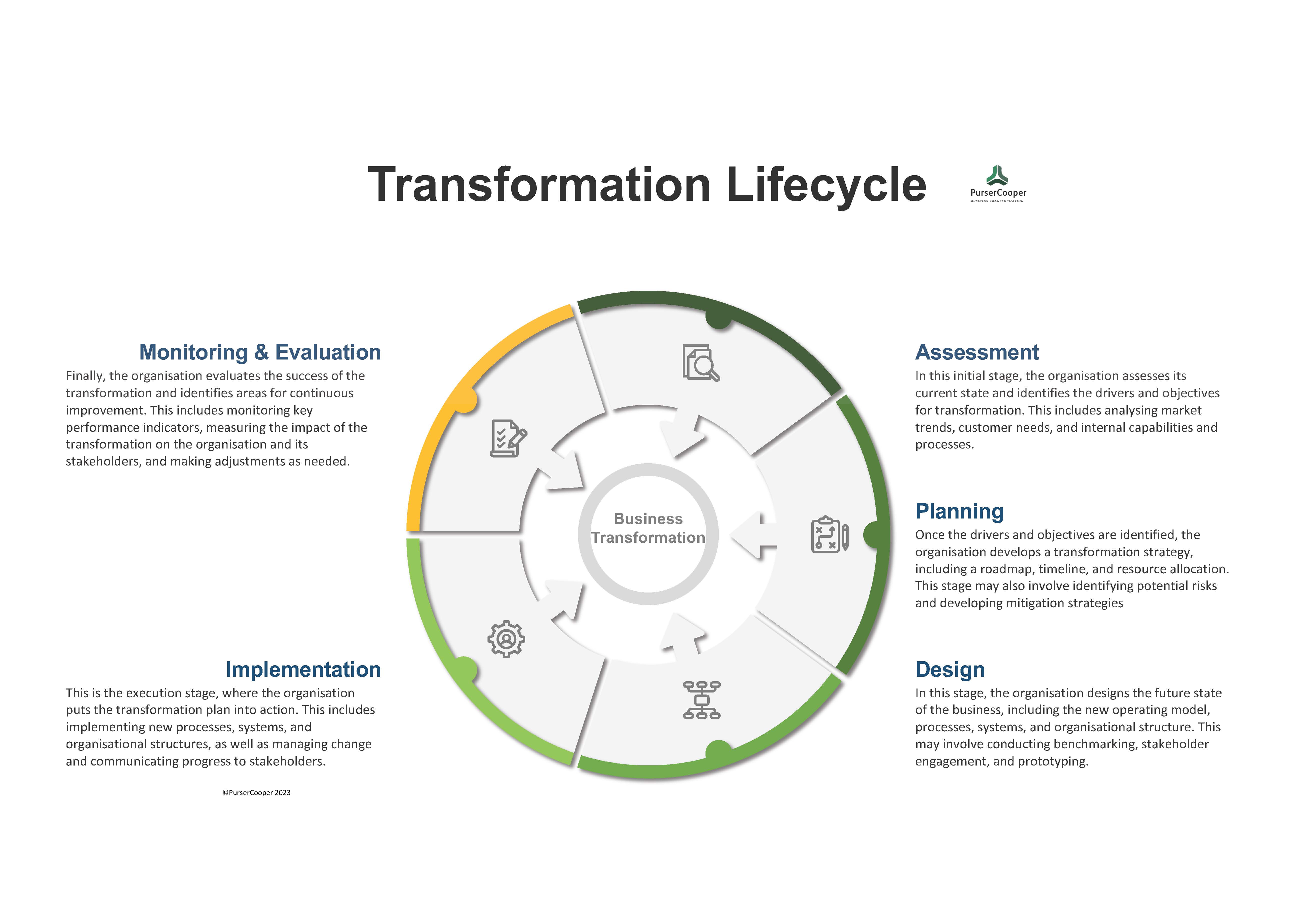Transformation
Future-proofing your business
Adapt, thrive, win
A successful turnaround is an opportunity to permanently alter the trajectory of a business, taking advantage of improved performance, lower cost base and operational philosophy that form its new DNA.
Having overcome financial pressures, restored staff morale, fixed broken business models, and with investors on side, the building blocks are in place for transformative change - using baked-in resilience to deliver greater value and long-term success.
Planning for transformation requires a framework that clarifies the present in the context of the future. We use these insights to develop a change roadmap that will get you from where you are to where you need to be. We begin with five questions, asked in the present and the envisaged future:
- What is your core business?
- Who have you got running it?
- Where do they do it?
- How do they do it?
- Why do you need to change now?

Business transformation involves significant changes to strategy, operations, and organisational structure alongside exploration of new markets and opportunities.
Defining your current core business identifies those products, services, and capabilities that you need to preserve and build on during the transformation. Staying focused on your core business maintains competitive advantage, avoids diluting your brand and reputation and ensures you are focused on areas that matter most to your customers and stakeholders.
Defining and understanding what your future core business looks like is critical in assessing the impact of change on your operations and informs decisions about resource allocation, talent management, and technology investments during the transformation journey.
Finally, defining your core business helps you to communicate your transformation strategy. By explaining how the transformation aligns with your core strengths and values, you can build trust and support for the changes that you are making among employees, customers, and stakeholders.
Understanding who does the work today and who will do it in the future is crucial for several reasons.
First, identifying the skills and knowledge that will be required in the future workforce will drive the creation of a training and development plan for your existing employees and a recruitment strategy for new staff to fill any skill gaps.
Second, analysis of how your current workforce operate helps identify processes that could be improved or automated in the future.
Automation is an essential component of many business transformations as it leads to enhancements in efficiency and productivity that translate into cost saving and increased profits. Automation can also free up time for employees to focus on more valuable work such as better customer service and innovation.
Understanding the current and future workforce is also important when considering the impact of transformation on your employees and developing a plan to manage any job losses resulting from change and automation.
Physical and virtual location strategies that are designed to support your business are important in a business transformation for several reasons:
Cost savings - factors such as real estate and rental prices, utilities, labour costs, and council rates and taxes help you save money.
Access to talent - being close to where the best talent can be attracted and retained is an important way of building and maintaining your competitive advantage.
Customer proximity - a location strategy that places you in close physical proximity to your customers can help you better understand their needs and serve them more effectively.
Risk management - factors such as weather, climate, natural disasters, political instability, and supply chain disruptions can help minimise exposure to risk.
Creating a digital workplace integrated with physical facilities provides numerous additional benefits such as:
Increased productivity - your employees work more efficiently when provided with tools that allow them to collaborate, communicate, and share information.
Improved communication - a digital workplace can facilitate better communication between your employees, customers, and other stakeholders, making it easier to share information and ideas.
Greater flexibility - where appropriate, employees who are able to work from anywhere, at any time, benefit from greater flexibility and work-life balance.
Enhanced customer experience - faster and more personalized service leads to increased customer satisfaction.
Analysis of present and future workplace location strategies can result in a broader environment that supports the business by generating tangible benefits.
Change involving improvements to how things get done plays a critical role in achieving operational excellence - a state of business where processes are optimised to achieve superior performance and efficiency. In a transformation, analysing current processes and systems is a crucial step in achieving future operational excellence. Here are a few reasons why:
Improved Efficiency - examining existing processes and systems identifies areas for future improvement and enhanced efficiency that translate into cost savings, better productivity, and smarter use of resources.
Increased Agility - in industries that are rapidly evolving or experiencing disruption, regular review and upgrading of systems and processes results in increased agility and innovation in response to changing market conditions.
Better Customer Experience - your customers want their products and services delivered consistently and efficiently. Optimising processes and systems reduces lead times, improves quality, and increases reliability, leading to a better customer experience. In turn this means increased customer satisfaction, loyalty, and retention.
Benchmark against best practices - benchmarking current operations against industry best practice identifies areas where improvements are required to bridge the gap between now, the future, and best-in-class practices.
Opportunities for automation - analysis of current processes and systems helps identify opportunities for future automation, which reduces errors, increases efficiency and frees up employees to work on higher-value tasks.
Improved data management - identifying the gaps between current data management capabilities and future needs drive the implementation of systems and processes to improve data collection, storage, analysis, and reporting - critical factors for making data-driven decisions and achieving future operational excellence.
Engaged employees - finally, involving employees in the analysis and redesign of processes and systems builds a sense of ownership and commitment to the changes, leading to better adoption and sustained operational excellence.
Business leaders are under pressure from many directions. Digital transformation, changing customer expectations, globalisation, talent management, environmental and social responsibility, disruptive competition and economic uncertainty are just some of the factors driving organisational change.
Given the increasing complexities of global markets and the need for data and analysis to navigate and respond to rapidly-evolving business conditions, being able to deliver financial and social value alongside the constant demand for improved performance means companies that want to survive, thrive and win must seek efficiency from people, process and technology like never before.
If you are looking for reasons to change now to succeed in the future, here are a few thoughts to keep top-of-mind as you consider a transformation for your business:
Create a Clear Vision - you need a clear strategic vision for the transformation to focus the organisation on what needs to be achieved and provide direction for the change efforts.
Monitor Customer and Market Changes - changes in your customer preferences, market trends, and competitor activity can derail a business transformation if you choose to react instead of adapt.
Embrace Technology - advances in technology create new opportunities for innovation and efficiency for you. Technology also disrupts existing business models, requiring you to transform in order to stay competitive.
Respond to Regulatory Requirements - changes in regulatory requirements can require your business to comply with new regulations, adopt new processes, and make changes to your business models.
Your Organisational Culture - the need to change the organisational culture and align it with a new strategic direction can also be a key driver of transformation.
Leadership - effective leadership is the key driver of change. As a leader you set the tone for your organisation and have the responsibility to create the culture of change and transformation.
Business transformation is necessary for businesses that want to remain competitive and relevant. By embracing change and continually evolving their operations, businesses can position themselves for long-term success and growth.
What to expect during a transformation
The business transformation lifecycle is a structured process that organisations follow to plan, execute, and measure the success of their transformation initiatives. While the specific steps may vary depending on the organisation, the typical stages of the business transformation lifecycle include: Assessment - where we are now; Planning - where we need to be; Design - how we will get there; Implementation - getting there; Monitoring & Evaluation - how we are performing against goals.
The business transformation lifecycle is a continuous process, and organisations may cycle through the stages multiple times as they continue to evolve and adapt to changing market conditions, customer needs, and technology advancements.

